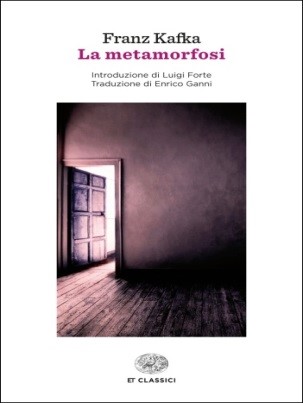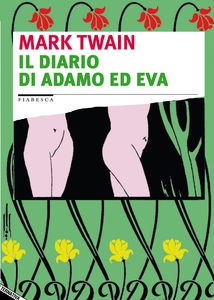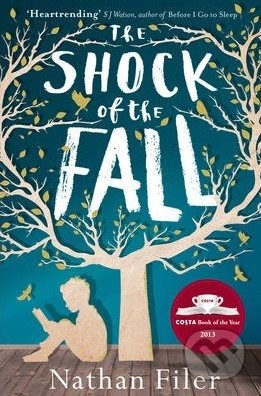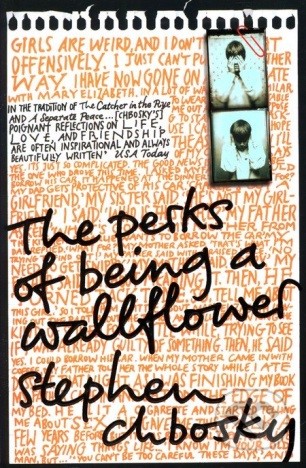
Handbook-subarticles
Book title
The metamorphosis
Author
Franz Kafka

Bibliographic information
Bur Biblioteca Universale-Rizzoli.2013
Links (adaptations, reviews, full texts etc.)
- http://www.scritturaimmanente.it/kafka/racconti/comm_metam/analisi.htm
- http://giorgiobaruzzi.altervista.org/blog/kafka-risveglio-gregor-samsa-metamorfosi/
Theme
Fantasy
Short summary
The Metamorphosis is a novella by Franz Kafka, first published in 1915. The story begins with a travelling salesman, Gregor Samsa, waking to find himself transformed into a large, monstrous insect-like creature. He is not concerned about his new physical appearance, but about his being unable to perform the tasks expected of him , as a model employee.
Why is the story appropriate for the targeted groups of RSP readers?
The novel can be considered a psychological fantasy, a genre which is highly appreciated by young readers, who especially tend to be interested in gaining a psychological insight of themselves in order to find out more about their mysterious inner world.
What are the distinguished readers interests reflected by this book/story?
Psychology appeals to young readers because they try to find explanations about their inner world and about what other people think of them.
Why is this story motivational for the pupils?
Because young readers are afraid of changes, even though they have to cope with them since adolescence is an age marked by great changes: from childhood to adolescence.
Is there a historical, political, multi/inter cultural, migrant or similar context recognized in this book/story?
No, there isn't.
Is there a principle of inclusion reflected in this book/story and does it promotes understanding of cultural diversities and heritage?
No, there isn't
Title of Activity
Reading for fun
Description of educational activity
Duration: 2 hours
Pupils’ age: 14-16
Organization of the class of pupils: group work
Pupils' tasks: Students read the extract “Gregor Samsa wakes up” from Kafka’s “Metamorphosis” and analyse it, following the teacher’s instructions. In this first step they work individually, in order to test their ability to analyse extracts, their knowledge of the psychological-fantasy genre and of the author. Then, they organize teams of 4-5 elements to simulate the quiz game broadcast by the third channel of Italian TV on Saturday afternoons “Per un pugno di libri”. Each team chooses the students who are in charge of answering the questions on authors, titles of works, genres, characters and contents of stories.
Support materials:
- The extract “Gregor Samsa wakes up” , from Kafka’s “Metamorphosis”.
- A Map of the fantasy genre: fantasy and fairy tales
- Brother Grimms’ fairy tales “Hansel and Gretel” “Cinderella” and “Little Red Riding Hood”, from : Jacob e Wilhelm Grimm, “Fiabe”- Oscar Classici-Mondadori.
- Lists of authors and titles of novels from different countries, read at school, given by the teacher.
Evaluation and assessment method:
The challenge triggers competition both inside the group and among the groups belonging to the other classes involved in the Project.
Games constitute an effective way of learning just because they actively involve all students, who learn while playing.
All students have read the 4 extracts proposed for the analysis and have done homework about them.
Connection to curriculum
Grade: 2nd grade
Knowledge:
- Narrative techniques
- Basic structures of narrative texts
- The fantasy genre and the fairy tales.
Skills:
- Being able to distinguish the peculiar characteristics of the literary genres, recognizing fantasy, horror and terror.
Competences:
- Reading
- Understanding and interpreting written texts of various kinds, and in particular, using information/knowledge to face a team game, following the rules.
Bibliographic reference to be used during the activity
Italian version
La Metamorfosi di Franz Kafka n. 70 pagine
Editore: Einaudi (7 marzo 2014)
Collana: Einaudi tascabili. Classici
Lingua: Italiano
ISBN-10: 8806220632
ISBN-13: 978-8806220631

Digital sources
The extract is well suited for the narrative analysis requested by the team game modelled on the tv programme “Per un pugno di libri”.
- http://www.perunpugnodilibri.rai.it/
- http://www.culturaitalia.it/viewItem.jsp?language=en&case=&id=oai%3Aoaicat.indire.it%3AD-JFVG4GFS
- http://doc.studenti.it/scheda-libro/italiano/5/metamorfosi-franz-kafka.html
- http://www.hoepli.it/libro/fiabe/9788804672050.html
Results
The science fiction genre is highly appreciated by young people who know it also thanks to the cinema. The literary text differs from the film as it does not involve the use of special effects, therefore it offers the opportunity for a deeper reflection on the themes and the possibility to analyse the characters accurately especially if we want to introduce creative writing.
Recommendations
The role play of the “impossible interview” arouses students’ interest and encourages accurate and intensive reading. It enriches vocabulary and fosters oral and written linguistic skills.
Title of Activity
How many facets in one story!
Description of educational activity
Duration: 3 lessons (2 lessons to prepare activity – one dedicated to the performance in class)
Pupils’ age: 15-16
Organization of the class of pupils: individual, pair and group work
The aim of the lesson: This activity is aimed at making students aware of the endless responses to the reading of a story: once they have carefully read it and grasped the author's message, they will be free to get a closer insight into it, change it, compare it, picture it, reverse it, refuse it, perform it, apply it in their real life, make a film or draw a comic of it .They will realise that it is live matter in their hands. It is therefore clear it is of paramount importance to know all the details and narrative techniques included in the text, to use imagination and creativity and to devote oneself to reading as a pleasant and enjoying activity.
In order to achieve this goal, the cubing method appears to be the most suitable technique to this purpose. When drawing on it, more faces can be added to the main ones so that each student could foster his/her imagination
First cube
- Describe it– Describe the main characters' physical features, habits and behaviours
- Compare it – Compare this story to others dealing with the same theme, even belonging to other literary and artistic genres
- Associate it – What are your thoughts when reading Adam and Eve's inmost feelings/diary?; name other real situations (girlfriends, sisters, mothers, grandmothers/ boyfriends, brothers, fathers, grandfathers) or literary / artistic contexts that you may associate the text with.
- Analyse it – a complete analysis of the text (author, title, plot, characters, places, time, themes)
- Apply it – Write one or more pages of a diary in which you outline a "bizarre" behaviour typical of a female/male figure you know
- Argue for and against it/Debate it – Express and motivate your ideas, supporting your point of view related to Adam's or Eve's behaviours
Second cube
- Dramatize it – dramatize a passage from the book, trying to imagine a dialogue between the two main characters (the book is made up of two diaries so, there is no verbal interaction between them)
- Cast it – choose the actors to whom you would assign the different roles
- Memorize it –choose a particularly meaningful passage from the book, learn it by heart and act it out in front of the class
- Set it to music –choose some music which could be linked to the text
- Illustrate it – choose a picture or a sculpture that may represent the text
- Change it into a cartoon- draw a comic on a passage from the text
Third cube
- Enjoy it – enjoy yourself while skimming and scanning the text
- Turn it upside down – tell the story from God's point of view or from Cain's or the snake's perspective-
- Change it – change and transform something you didn't like in the story
- Satirize it –what would Adam and Eve argue nowadays? Imagine an ironic and funny scene on the most popular reasons for misunderstandings between girls and boys or on their different views of the world.
- Conduct an interview – (interview the main characters. they are willing to disclose their experiences) imagine you were interviewing the main characters on the man-woman relationship. Provide the answers!
- Make it known-- prepare a poster, highlighting a particularly meaningful passage
Support materials:
- the book
- Three templates to shape the three cubes
- Cardboard to build the cubes
- Students' works
- 18 worksheets corresponding to the faces of three cubes, devise dby the teacher to show students the different learning paths/tasks to carry out
Activities:
In order to make the most of the following activity, students have to read the book thoroughly.
1. each student will have to work individually and in pair on the activities shown on the 18 faces of the three cubes as well as to make appropriate references to some parts of the plot.
2. students will have to prepare a presentation of their works: ach of them will cast the different dice on every face and will have to present his/her output/work regarding the request and stick it on one of the billboards, already made in class
Great importance will be given to debriefing: a moment devoted to reflection, reassembling and analysis of the activity, thus promoting the collective exchange of opinions, the detection of difficult problems and, finally, the results of the learning process
Evaluation and assessment method:
In order to evaluate the activity, students are asked:
- to orally present their works
- to present their homework
The quality of the students' homework and their active participation in class will be taken into consideration for their evaluation.
Effect of the activity on RSP reading:
the main themes as well as the ironic and poetical way of dealing with them, the possibility of discussing the relationship between boys and girls, the suggestion of workshops closely linked to the text contribute to increasing young people’ interest and pleasure in reading and writing, as well.
Connection to curriculum
Grade: 2nd grade
Scientific curriculum: during the second year the study of literature is focused on
- improving oral and written skills and competences.
- improving reading skills, understanding and analysing, specifically, literary texts, but also devoting attention to non-literary texts and non-verbal languages.
- learning how to build up and understand the historical and cultural context regarding the texts
Knowledge:
- Singling out the context, the aim and the addressee of the communication;
- Learning the different reading techniques;
- Developing reading fluency
- Improving reading comprehension
Skills:
- Dealing with different communicative situations
- Understanding other people's point of view in formal and informal contexts;
- Applying different reading strategies;
- Singling out the different elements of communication;
- Searching, finding and selecting information;
- Expressing ideas and supporting arguments
- Selecting appropriate media
- Reflecting on learning
- Learning by playing
- Drawing conclusions
- Asking clarifying questions
- Improving presentation before an audience
- Improving use of vocabulary, spelling, syntax and expression
Bibliographic reference to be used during the activity
Italian version
Il diario di Adamo ed Eva
Original title: The diaries of Adam ed Eve
Translator: G. Sordini
Editore: Stampa Alternativa
Collana: Fiabesca
Year of issue: 1999
(First published in the 1905 Christmas issue of the magazine Harper's Bazaar, with te title Eve's diary and in book format in June 1906 by Harper and Brothers publishing house).
Pages: 80
EAN: 9788872265338

Digital sources
Audiobooks:
Eve’s diary
- Italian version
https://www.youtube.com/watch?v=Rc7OTUkUxLg
https://www.youtube.com/watch?v=Dzp7p9FKKIg
Adam and Eve’s diary
- English version
https://www.youtube.com/watch?v=jt21eZIhGZ4
https://www.youtube.com/watch?v=yNrBoedfJHA
https://www.youtube.com/watch?v=QoQZ_weijTQ
Results
The expected outcomes of the lesson are that the students will be able to:
- recreate the story many time with different means of communication
- establish relationships between texts from different literary genres
- compare their own interpretations with other people's views
Recommendations
Such a methodology implies the creation of creative and effective learning moments/environments in order to:
- enrich students' experience and knowledge;
- favour research;
- promote cooperative learning
- make students aware of their learning style;
- turning traditional teaching activities into active workshops
Title of Activity
Character comparison
Description of educational activity
Duration: 45 minutes
Pupils’ age: 15-19
Organization of the class of pupils: group work
The aim of the lesson: The aim of this activity is to develop reading literacy of students, encourage their reading skills, use of their competences at the analysis and interpretation of the initial texts, to strengthen their language skills at verbalisation of their finding and to expand the vocabulary of students. It is important to be able to present the findings, express student´s opinion and to be able to accept the opinions of other members of a group or class.
The aim of the activity is to create student´s own text – comparative characteristic of the main characters of the selected stories, based on the analysis and his reading experience. The next aim is to develop analytical mind of the students.
Support materials:
Teacher – a coordinator of the activity, chooses some short excerpts from two books (equal number of the excerpts from each book), which somehow characterize the main character of a story. Each excerpt is printed on a separate piece of paper without indicating the author and the title of a book. The examples of suitable excerpts are shown in this activity and we chose them from the books The shock of the fall (N. Filer) and The perks of being a wallflower (S. Chbosky), because the heroes of both of the stories are similar in their age, attitudes and their life situation.
Activities:
- Divide students into groups as follows: Put numbered pieces of papers into a hat and each student chooses one of them. There are more pieces of paper with the same number so we can make groups of student randomly. Students with number 1 will form a group, with number 2 another one etc.
- Each group is given excerpts from both of the books. Their first task is to read them and divide them into two groups/ two stories. The students can choose the form of reading so they can read individually or reading our loud with listening actively.
- Based on the excerpts, the students fill in the worksheet (appendix 2), so they match the main characters with the adjectives and phraseological expressions which characterize them. They choose their own form of work within a group. A thorough analysis of the excerpts is important, so the students do not only analyse the content but have to focus on intertextual links and author´s stylistics.
- After the adequate analysis of the characters, the groups work out a comparative characteristic of the main characters. They try to find the differences and similarities of the main characters.
- Subsequently the groups present their characteristics and discuss obtained information, compare their findings. Within the discussion they might change their opinion on a character.
- A teacher should now introduce the authors of the books to the students e.g. using a PowerPoint presentation. If there is no time to carry out this part of the activity, it can be left out as it is not the focus of the activity. The teacher is, in all the phases of the activity, a coordinator and facilitator of the activity.
- In the end the students watch a short part of the film versions of the books and discuss the differences.
Connection to curriculum
Grade: 2nd and 3rd grade of bilingual studies
Bilingual curriculum: The study of literature is focused during the second and third year on reading comprehension of literary texts which are based on the interests of the students which involves books with teenage protagonists, too. The aim of the curriculum is to teach students to w0ork with the text, to analyse the texts. Comparing different characters and being able to talk about their features and analysing their qualities and vices. Understanding texts, weighing their merits, and utilizing the information they offer are skills that teenagers draw on throughout the curriculum.
Knowledge:
- Students understand a text being read.
- Students find the main character in a text.
- They differentiate supporting characters from the main character.
- After reading the excerpts they can identify the main characteristics of the characters.
- They identify the topic of the excerpts
- They select information.
Skills:
- Students analyse texts.
- They work with dictionaries.
- They search for and classify information.
- They can identify and interpret correctly the feelings of the characters in the books
- They can put the particular excerpts in the correct order according to some links.
- They are able to work in groups.
- They can create a characteristic of a character based on the excerpts.
Competences:
- Students are able to work individually or in a team
- They accept others in the group
- They can express their opinion
Bibliographic reference to be used during the activity
Filer Nathan: The shock of the fall
Publisher: HarperCollins Publishers
ISBN: 9780007491452
Page count: 320
Year of issue: 2014

Digital sources
Reviews:
- https://www.theguardian.com/books/2014/jan/18/shock-fall-nathan-filer-review
- http://www.independent.co.uk/arts-entertainment/books/reviews/the-shock-of-the-fall-by-nathan-filer-book-review-moved-by-the-dark-humour-in-a-poignant-debut-9073069.html
Results
The expected outcomes of the lesson are:
- The students will be able to understand through character comparison, develop demonstrations.
- To connect ideas and themes across texts.
- To find hints to help to find the qualities of characters
- To offer observations, make connections, speculate, interpret, and raise questions in response to the excerpts.
Recommendations
Both the teaching method and the text can help in increasing students’ interest in reading. These excerpts promote male characters with whom boys can identify. But the text is about teenage characters so girls can be interested in the reading as well as they are sentimental or even a little bit romantic. But on the other hand these books have deeper messages.
The teacher monitors the students so as to make sure they cooperate effectively.
The volume of given fragments of books can be adapted to the potential of a group - fragments can be shorter - by cutting less important paragraphs, or be expanded to additional fragments of the same novel.
Book title
The shock of the fall
Author
Nathan Filer

Bibliographic information
Publisher: HarperCollins Publishers
ISBN: 978-0007491452
Links (adaptations, reviews, full texts etc.)
- http://www.goodreads.com/book/show/16120760-the-shock-of-the-fall
- https://www.theguardian.com/books/2014/jan/18/shock-fall-nathan-filer-review
Theme
The theme of loss, grief and mental illness
Short summary
The Shock of the Fall by Nathan Filer, tells the story of Matthew and Simon, two brothers who are separated yet united by a tragic accident. While they are on vacation with their parents, Matthew Homes and his older brother snuck out in the middle of the night. Only Matthew came home safely. Ten years later, Matthew tells us, he has found a way to bring his brother back. The book is full of grief, loss and Matthew suffers from a mental disease. It’s a very unusual narrative, but also both funny and inventive. The book describes the close bonds between the main character and his grandmother.
Why is the story appropriate for the targeted groups of RSP readers?
- it reflects readers´ interests
- the recommendation and the report emerged from the survey results
What are the distinguished readers interests reflected by this book/story?
-
Why is this story motivational for the pupils?
The story deals with suffering and grief and how close family bonds can help overcome all the problems. The story reveals the problems of a boy who suffers from Schizophrenia.
Is there a historical, political, multi/inter cultural, migrant or similar context recognized in this book/story?
No.
Is there a principle of inclusion reflected in this book/story and does it promotes understanding of cultural diversities and heritage?
It emphasizes the importance of family bonds and the bonds between siblings.
Title of Activity
Character comparison
Description of educational activity
Duration: 45 minutes
Pupils’ age: 15-19
Organization of the class of pupils: group work
The aim of the lesson: The aim of this activity is to develop reading literacy of students, encourage their reading skills, use of their competences at the analysis and interpretation of the initial texts, to strengthen their language skills at verbalisation of their finding and to expand the vocabulary of students. It is important to be able to present the findings, express student´s opinion and to be able to accept the opinions of other members of a group or class.
The aim of the activity is to create student´s own text – comparative characteristic of the main characters of the selected stories, based on the analysis and his reading experience. The next aim is to develop analytical mind of the students.
Support materials:
Teacher – a coordinator of the activity, chooses some short excerpts from two books (equal number of the excerpts from each book), which somehow characterize the main character of a story. Each excerpt is printed on a separate piece of paper without indicating the author and the title of a book. The examples of suitable excerpts are shown in this activity and we chose them from the books. The shock of the fall (N. Filer) and The perks of being a wallflower (S. Chbosky), because the heroes of both of the stories are similar in their age, attitudes and their life situation.
Activities:
- Divide students into groups as follows: Put numbered pieces of papers into a hat and each student chooses one of them. There are more pieces of paper with the same number so we can make groups of student randomly. Students with number 1 will form a group, with number 2 another one etc.
- Each group is given excerpts from both of the books. Their first task is to read them and divide them into two groups/ two stories. The students can choose the form of reading so they can read individually or reading our loud with listening actively.
- Based on the excerpts, the students fill in the worksheet (appendix 2), so they match the main characters with the adjectives and phraseological expressions which characterize them. They choose their own form of work within a group. A thorough analysis of the excerpts is important, so the students do not only analyse the content but have to focus on intertextual links and author´s stylistics.
- After the adequate analysis of the characters, the groups work out a comparative characteristic of the main characters. They try to find the differences and similarities of the main characters.
- Subsequently the groups present their characteristics and discuss obtained information, compare their findings. Within the discussion they might change their opinion on a character.
- A teacher should now introduce the authors of the books to the students e.g. using a PowerPoint presentation. If there is no time to carry out this part of the activity, it can be left out as it is not the focus of the activity. The teacher is, in all the phases of the activity, a coordinator and facilitator of the activity.
- In the end the students watch a short part of the film versions of the books and discuss the differences.
Connection to curriculum
Grade: 2nd and 3rd grade of bilingual studies
Bilingual curriculum: The study of literature is focused during the second and third year on reading comprehension of literary texts which are based on the interests of the students which involves books with teenage protagonists, too. The aim of the curriculum is to teach students to w0ork with the text, to analyse the texts. Comparing different characters and being able to talk about their features and analysing their qualities and vices. Understanding texts, weighing their merits, and utilizing the information they offer are skills that teenagers draw on throughout the curriculum.
Knowledge:
- Students understand a text being read.
- Students find the main character in a text.
- They differentiate supporting characters from the main character.
- After reading the excerpts they can identify the main characteristics of the characters.
- They identify the topic of the excerpts
- They select information.
Skills:
- Students analyse texts.
- They work with dictionaries.
- They search for and classify information.
- They can identify and interpret correctly the feelings of the characters in the books
- They can put the particular excerpts in the correct order according to some links.
- They are able to work in groups.
- They can create a characteristic of a character based on the excerpts.
Competences:
- Students are able to work individually or in a team
- They accept others in the group
- They can express their opinion
Bibliographic reference to be used during the activity
Chbosky Stephen: The perks of being a wallflower
Publisher: Pocket Books
ISBN: 9781847394071
Page count: 224
Year of issue: 2012

Digital sources
The Perks of Being a Wallflower is a 2012 American coming-of-age, drama film. An adaptation of the 1999 epistolary novel of the same name, it was written and directed by the novel's author, Stephen Chbosky. Filmed in Pittsburgh, Pennsylvania, the film was released on September 21, 2012. The film stars Logan Lerman, Emma Watson and Ezra Miller.
Results
The expected outcomes of the lesson are:
- The students will be able to understand through character comparison, develop demonstrations.
- To connect ideas and themes across texts.
- To find hints to help to find the qualities of characters
- To offer observations, make connections, speculate, interpret, and raise questions in response to the excerpts.
Recommendations
Both the teaching method and the text can help in increasing students’ interest in reading. These excerpts promote male characters with whom boys can identify. But the text is about teenage characters so girls can be interested in the reading as well as they are sentimental or even a little bit romantic. But on the other hand these books have deeper messages.
The teacher monitors the students so as to make sure they cooperate effectively.
The volume of given fragments of books can be adapted to the potential of a group - fragments can be shorter - by cutting less important paragraphs, or be expanded to additional fragments of the same novel.
Contact
X gimnazija ''Ivan Supek''
Ul. Vjekoslava Klaića 7
10000
Zagreb
E-mail: partners@handbook4rspreaders.org










